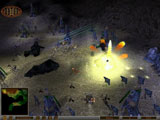 It’s the dead of night. You have been at
your computer for hours, crunching numbers and going over the projections on the large
wall-size monitors in your lab. An assistant
comes in with another carafe of coffee. You
could use a little rest, but as the leading astro-physicist for the Lunar Corporation your
job is never done. There is always something
that needs to be checked or investigated: solar anomalies, space radiation, lunar dust,
and other perils that the residents of the moon trust to your care. It’s the dead of night. You have been at
your computer for hours, crunching numbers and going over the projections on the large
wall-size monitors in your lab. An assistant
comes in with another carafe of coffee. You
could use a little rest, but as the leading astro-physicist for the Lunar Corporation your
job is never done. There is always something
that needs to be checked or investigated: solar anomalies, space radiation, lunar dust,
and other perils that the residents of the moon trust to your care.
The soft hum of the printer coming
online to display your test results snaps you back to reality. As you slowly collect your cup of coffee and make
your way over to retrieve the printout, you wonder briefly how things are going back on
Earth. The printer finishes its job and the
report waits in its tray. You gather it
up and make your way back to the desk. Everything
appears to be in order … but wait, what's this?
A small shift in the Earth’s rotation? How
can that be? Grabbing your data pad you begin
another set of calculations. All weariness has fled. As the solution scrolls across the
screen, an impending sense of doom floods your nerves and synapses. The coffee cup slips from your hand and crashes to
the floor. The assistant spins around to see
you slack-jawed and trembling. If the
numbers are right, at this rate of orbital decay there are only 183 days before Earth
collides with the sun…
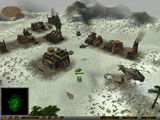 Don't worry, though, game fans. This isn't the story behind a
late-breaking headline of impending disaster. It’s Earth 2150, one of this
summer’s hottest RTS games. You
assume command of one of the three Earth factions (Eurasian Dynasty, United Civilized
States, or Lunar Corporation) and try to lead your people away from the dying earth to
safety on Mars. To succeed, you have to fend
off other factions’ advances and mine minerals to pay for transportation for
the trip before the Earth and Sun collide. All you need to do is collect a million credits
and you win. Keeping them, though, isn't so
easy. Don't worry, though, game fans. This isn't the story behind a
late-breaking headline of impending disaster. It’s Earth 2150, one of this
summer’s hottest RTS games. You
assume command of one of the three Earth factions (Eurasian Dynasty, United Civilized
States, or Lunar Corporation) and try to lead your people away from the dying earth to
safety on Mars. To succeed, you have to fend
off other factions’ advances and mine minerals to pay for transportation for
the trip before the Earth and Sun collide. All you need to do is collect a million credits
and you win. Keeping them, though, isn't so
easy.
As the game begins, you assume
command of a fully functioning base. The
Earth bound factions (ED & UCS) need to gather a million credits to move their people
to safety. The LC, on the moon, only needs to
gather half a million credits because they are the most technically advanced of the three. But the LC has to get all those credits up to the
moon so that they can get to Mars.
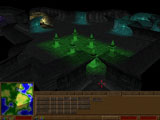 Once underway, you will find yourself in command of your
stationary “home-base” and a “field-base”. The field-bases move from location to location
frantically mining for the resources that will save your people. Along the way these bases will also have to defend
these same resources from factions also vying for self preservation. This resource management can be EXTREMELY
confusing in the beginning. To alleviate
this, there are several different camera options that can help quite a bit, once you get
the hang of it. Just think, this is only the
base management. You still have to manage your finances and your troops. Once underway, you will find yourself in command of your
stationary “home-base” and a “field-base”. The field-bases move from location to location
frantically mining for the resources that will save your people. Along the way these bases will also have to defend
these same resources from factions also vying for self preservation. This resource management can be EXTREMELY
confusing in the beginning. To alleviate
this, there are several different camera options that can help quite a bit, once you get
the hang of it. Just think, this is only the
base management. You still have to manage your finances and your troops.
The credits that you collect are used
for everything in the game, so learning how to manage them effectively is imperative to
your success. Thankfully, at the end of each
mission, you get to keep your units (those that are not destroyed anyway) and they will
earn experience for the combat that they have faced.
The downside of this is that you really don’t want to send all your troops in
on a suicide mission, since you would have to replace them in the next mission.
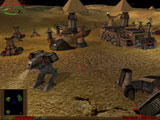 During combat and construction, players really notice the amazing
graphics. Everything, the landscape,
climate, structures, and vehicles, possesses an impressive level of detail. Various military and civilian units under your
command look superb. Days and nights pass and the structures that make up your base turn lights on and off
accordingly. At times, rain and snow obstruct
the view, making commanding difficult. Fortunately, the camera is fully adjustable and can
be rotated and zoomed in and out to get the best view possible on the battlefield. While these controls are confusing at first, with
time and practice they definitely come in handy. During combat and construction, players really notice the amazing
graphics. Everything, the landscape,
climate, structures, and vehicles, possesses an impressive level of detail. Various military and civilian units under your
command look superb. Days and nights pass and the structures that make up your base turn lights on and off
accordingly. At times, rain and snow obstruct
the view, making commanding difficult. Fortunately, the camera is fully adjustable and can
be rotated and zoomed in and out to get the best view possible on the battlefield. While these controls are confusing at first, with
time and practice they definitely come in handy.
The entire interface can be rather
daunting when you first sit down with the game because there are so many options to
choose from. There are lots of things to
learn at the beginning, so patience and some playing time are required to get everything
out of Earth 2150. The small dictionary-sized
manual and the in-game tutorials are also helpful.
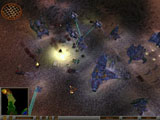 There are so many options
in this game that it is hard to take everything into account. This could be an EXCELLENT multi-player game. I was only able to manage playing a little LAN
game and it played like a dream. This is one
of the few RTS games that has so many multi-player options.
These include Uncle Sam (unlimited resources), Earn Money (goal is earning $$), Kill’Em All (DM), Arena (no bases,
just battle), Destroy Structures (destroy all buildings), and Hide-n-Seek
(like capture the flag). With all these
options it should keep you busy for some time, even after you finish the game. There are so many options
in this game that it is hard to take everything into account. This could be an EXCELLENT multi-player game. I was only able to manage playing a little LAN
game and it played like a dream. This is one
of the few RTS games that has so many multi-player options.
These include Uncle Sam (unlimited resources), Earn Money (goal is earning $$), Kill’Em All (DM), Arena (no bases,
just battle), Destroy Structures (destroy all buildings), and Hide-n-Seek
(like capture the flag). With all these
options it should keep you busy for some time, even after you finish the game.
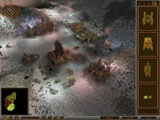 All in all, this is a pretty incredible game. The only down side to this piece is the steep learning
curve. The interface and controls can be
extremely intimidating at first. Other than
that, Earth 2150 gets a big thumbs-up. Any
game fan who likes a challenge should check out this challenging, graphically pleasing
RTS. All in all, this is a pretty incredible game. The only down side to this piece is the steep learning
curve. The interface and controls can be
extremely intimidating at first. Other than
that, Earth 2150 gets a big thumbs-up. Any
game fan who likes a challenge should check out this challenging, graphically pleasing
RTS.
--Ben Moore |
